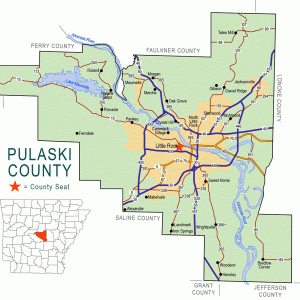calsfoundation@cals.org
Crystal Hill (Pulaski County)
Crystal Hill is a geological formation on the north side of the Arkansas River near Murray Lock and Dam. It is also the name of a neighborhood in the city of North Little Rock (Pulaski County). Nearby Pyeatte-Mason Cemetery contains the graves of some of the early settlers of Crystal Hill.
The formation, about seven miles upstream from downtown Little Rock (Pulaski County)—although many early travelers exaggerated the distance to fifteen miles—is a bluff consisting of sandstone and shale. It also contains significant amounts of iron pyrite, which sparkles in the sunlight. River travelers, seeing the sparkle, gave the hill its poetic name.
East Arkansas settlers displaced by the New Madrid Earthquakes of 1811–1812 began to settle this part of Arkansas in 1812. David and Jonathan Pharr, Lewis and John Hynam, and William F. Lockwood claimed land nearest the hill. Brothers James, Jacob, and John Pyeatt settled immediately upstream, in the area that is now Maumelle (Pulaski County). James Pyeatt operated a ferry across the Arkansas River. John Carnahan, a minister of the Cumberland Presbyterian Church, lived in the same area; he is said to have preached the first Protestant sermon in Arkansas.
Louis Bringier is said to have mined for silver in the Crystal Hill area, although the exact location of his mine is uncertain. Territorial governor James Miller purchased land near Crystal Hill on March 15, 1821. This purchase followed the decision of the territorial legislature to move the capital from Arkansas Post (Arkansas County) to Little Rock. Although that vote was taken in mid-October 1820, and the Cadron Settlement in what is now Faulkner County was the principal rival to Little Rock, some historians have suggested that Miller intended to profit from the land purchase by selling the land to the government.
The area remained sparsely populated and was never platted as a city or incorporated. After World War II, North Little Rock acquired land near Crystal Hill, which it developed as Burns Park. Interstates 40 and 430 were then built through the area, leading to more construction of houses and businesses. Maumelle was developed to the west of Crystal Hill in the 1970s and was incorporated in 1985. Wild River Country, a twenty-six-acre water theme park, opened in Crystal Hill in 1985. Crystal Hill Elementary School opened in the fall of 1993 and is a magnet school for prekindergarten through fifth grade, geared toward communications and technology.
Parts of Crystal Hill are now within the city limits of North Little Rock, while other parts remain unincorporated.
For additional information:
Maxwell, Nancy. “Born to Lead: Jacob Pyeatt and the Journey to Arkansas.” Pulaski County Historical Review 36 (Winter 1988): 74–81.
Ross, Margaret Smith. “Squatters Rights, Part II: Crystal Hill–Maumelle–Palarm Settlers Prior to 1814.” Pulaski County Historical Review50 (Fall 2002): 50–67.
Taylor, Joseph G. “Arkansas’s First Protestant Sermon.” Arkansas Gazette Magazine, December 13, 1936, p. 7.
Williams, W. D. “Louis Bringier and His Description of Arkansas in 1812.” Arkansas Historical Review 48 (Summer 1989): 108–136.
Julanne S. Allison
University of Arkansas, Fayetteville
Staff of the CALS Encyclopedia of Arkansas






Comments
No comments on this entry yet.